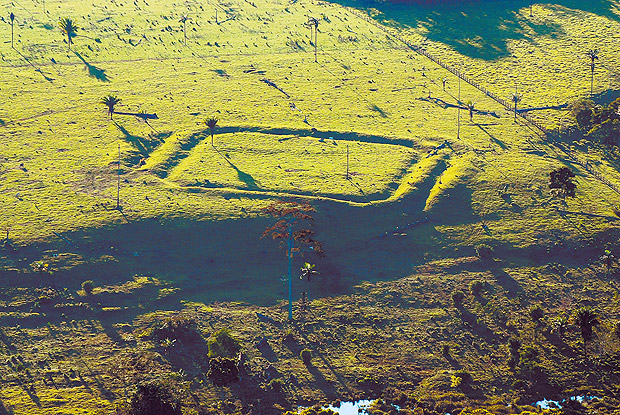Latest Photo Galleries
Brazilian Markets
10h39 Bovespa |
-0,96% | 124.363 |
16h43 Gold |
0,00% | 117 |
10h36 Dollar |
+0,31% | 5,1856 |
16h30 Euro |
+0,49% | 2,65250 |
ADVERTISING
Enigma of the Amazon Earthworks Solved
03/27/2017 - 13h04
Advertising
REINALDO JOSÉ LOPES
COLLABORATION FOR FOLHA
The mystery of the Amazon geoglyphs might be coming to an end soon. There are more than 500 of these strange geometric designs spread throughout the territory of the Brazilian state of Acre, some of them as wide as three city blocks.
All of them were made before the arrival of Europeans in Brazil.
The earthworks seem to signal the presence of complex indigenous societies comprised of many individuals who might have deforested a major part of the area to build their monuments.
However a new analysis suggests that the geoglyphs did not last very long and could be produced by smaller indigenous groups.
These conclusions, which show how little is known about the pre-historic period of the Amazon, are in a study published recently by "PNAS" journal.
"What is interesting about the geoglyphs is that they show two things: the Amazon was widely manipulated by ancient communities; and that occurred in different ways in different places, according to each community's specific ecologic conditions and cultural background," says archeologist Denise Schaan, of the Anthropology Department of UFPA (Federal University of Pará), the coauthor of the study along with researchers such as Alceu Ranzi, of the Federal University of Acre, and the U.K.'s Jennifer Watling, of USP and the University of Exeter.
The geoglyphs in Acre were first defined recently as deforestation advanced - the earthworks were covered by the forest.
There are few remains of pre-Columbian ceramic in the surroundings of the earthworks, and virtually no sign of long-term human occupation.
The dating carried out so far suggests that most of them were made between 2,000 and 650 years ago. The hypothesis accepted so far is that they were used as large ceremonial centers - major sites for parties and dance, for example.
| Diego Gurgel/Divulgação | ||
 |
||
| Geoglyphs on deforested land in the Amazon rainforest |
Researchers carried out excavations in two geoglyphs, some 10 kilometers from each other. The analysis indicated that, as it occurred before the current wave of deforestation, at the time the geoglyphs were made, Acre was dominated by a characteristic forest, with abundant species of bamboo.
There are signs of huge forest fires that occurred in the region 4,000 years ago - a long time before the earthworks were made.
After these events, the composition of the species in the forest changed a lot, with a 30% increase in the number of palm trees.
That indicates that there were already indigenous groups in the area interfering in the composition of species in the forest in their favor, as palm trees (for example, the pupunha palm tree), are among the most managed and domesticated species among the native groups of the Amazon.
Translated by THOMAS MUELLO



